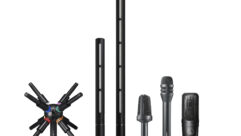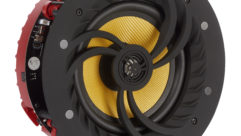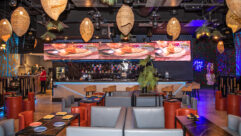Consultant’s Forum: Digital Audio Networks
Digital audio networking has recently become more mainstream, with several viable options now available from established suppliers. Although it hasn’t yet fully replaced analog signal distribution, many leading audio consultants believe that the benefits of digital audio networking will continue to drive this transition in the near future.
Meet the Consultants
1. Vance Breshears (VB) is principal consultant with Sound Technology Consultants, El Cajon, CA. Concentrating on sound systems design and room acoustics, Sound Technology Consultants focuses on churches, convention spaces, and themed entertainment venues.
2. Gary Hardesty (GH) is principal consultant with Sound Media Fusion, Los Angeles, where he has designed and supervised audio systems for multiple Olympic Games, as well as appearances by Pope John Paul II, Super Bowls, Asian Games, and World Cup soccer. Before establishing his own practice, Hardesty was vice president of engineering for JBL and EAW.
3. At Santa Monica, CA-based Jaffe Holden Acoustics, Benjamin Bausher’s (BB) project involvement includes electro-acoustics work for the Kennedy Center Opera House, the Southwest Center for the Performing Arts in Amarillo, TX, the Charlotte Children’s Learning Center, and the Memorial Sloan Kettering Cancer Center in New York. While at Artec Consultants, Bausher did extensive research on the design and implementation of digital audio networking and signal transport systems. His work at Jaffe Holden Acoustics is about 80 percent performing arts (theaters, concert halls, auditoriums), 10 percent worship spaces, and 10 percent educational (classrooms and lecture halls).
4. Josh Thompson (JT) is a senior consultant with Polysonics Corp., a full-service firm located in Washington, D.C., serving both government and private clients focused on acoustics and technology consulting. Current projects are in the defense/homeland security, sports, performing arts, worship, high-rise corporate, and residential market sectors. His past projects include the Hard Rock Hotel in Las Vegas, the Kentucky, Las Vegas, Erie, PA, Atlanta, and Iowa Speedways, and the American Airlines Arena in Miami. He’s also an instructor in media technology at Northern Virginia Community College.
5. David Revel (DR) is the principal consultant at Technical Multimedia Design Inc., a firm based in Palm Harbor, FL, specializing in design and automation of audio and video systems for theatrical and corporate multimedia presentations. Most recently, Revel worked as a consultant to a major theme park design group, contributing to the design and implementation of audio, video, and network systems for theme parks and attractions in Tokyo, Anaheim, CA, Orlando, FL, Paris, and Hong Kong.
Digital audio networking has recently become more mainstream, with several viable options now available from established suppliers. Although it hasn’t yet fully replaced analog signal distribution, many leading audio consultants believe that the benefits of digital audio networking will continue to drive this transition in the near future. In this article, Pro AV gathered five veteran audio professionals with significant experience with digital audio networks to discuss the future of this promising technology. While it’s sometimes difficult to get five consultants to agree on anything, one theme is common: Digital audio networking is here to stay, and its benefits are real.
Q: What aspects of a project do you feel make it an ideal candidate for digital signal distribution?
VB: If there’s a large quantity of audio signals, such as many mic lines, mic splits, etc., and the distance that audio must be transported is significant, it’s appropriate to use a digital network.
GH: I would say complex arrays over a long distance.
BB: There are several aspects, including: cost savings (from the integration of DSP into the digital signal distribution network, in some cases, along with less conduit and cable infrastructure); the need for different signals to be injected and extracted from the distribution fabric at different locations; and the need for control of the network and DSP from many locations.
JT: Scale, both in terms of channel count and distribution, is usually the deciding factor, but Polysonics rarely specifies analog distribution in projects anymore.
DR: Any project that uses digital source material or DSP will benefit from digital signal distribution. Projects that aren’t well defined at the outset can also benefit from the added flexibility of digital distribution.
Q: Likewise, what makes a prime candidate for analog signal distribution?
VB: I would say simpler systems with shorter runs and fewer signals.
GH: I agree. Short distances, simpler, more “typical” projects.
BB: I would add a client’s hesitance to implement digital audio technology and situations where there’s no “perfect” digital product for a particular problem.
JT: Again, scale modified by budget drives the decision. A small venue with short-haul distribution doesn’t yet receive the same value per channel of digital audio as a larger one would.
DR: Smaller projects — both in terms of venue size and channel count — are prime candidates for analog.
Q: On a digital project, do you use Ethernet-based technologies, or proprietary network protocols?
VB: Both. We’ve used Cobranet and Ethersound — which are both Ethernet-based technologies — as well as AES/EBU, MADI, and A-Net.
GH: Both.
BB: Generally, we use Ethernet-based technologies.
JT: Typically, we use Cobranet or Ethersound for long-haul and MADI/AES for shorter jumps.
DR: We prefer to use Ethernet-based technologies, which provide benefits of scale in cost and availability due to the market size of the overall computer industry. We try to avoid using proprietary protocols.
Q: What are the main factors that have influenced you in this decision?
VB: Definitely simplicity of cabling and distribution, and the availability of off-the-shelf hardware and cabling.
GH: I’d say the requirements of a special event, network latency, the number of inputs and outputs needed, cost, and international availability.
BB: Ethernet cabling is very cheap, very easy to install, has a good future, and the products that use Ethernet fit the price points that we and our clients need.
JT: You’ve read the brochures: reduced conduit and cabling requirements, which are increasingly important cost factors, simplified distribution and installation, EMI/RFI rejection, and low noise.
DR: The Ethernet standard provides the benefits of scale in terms of lower price, large variety of equipment selection, and easy availability of compatible components worldwide due to the large market size of the computer industry.
Q: What do you look for when selecting a networking technology for a project?
VB: The ability to split microphone lines, flexible signal routing, and the ability to transport over fiber.
GH: International support, redundancy, flexibility to handle creative design choices, sound quality, and low latency.
BB: The presence of DSP integrated into the network I/O boxes, flexible control options, and top-quality A/D and D/A conversion. Also low latency, ease of programming, digital I/O, and the ability to flexibly allocate I/O around the network without wasting inputs or outputs. That means the availability of an “all input” box or an “all output” box, rather than a 4-in 12-out box whose inputs will never be used.
JT: On the network side, definitely quality of service or QoS and cost. On the audio side, there’s cost, manageability, low latency, and, ultimately, audio quality.
DR: I’d say transparent audio quality is top priority. There’s also integration of the technology into a variety of DSP resources to minimize components and interconnections and A/D-D/A conversions. Don’t forget about flexibility in terms of inputs and outputs as well as channel density as a function of bandwidth and VLAN count. Finally, we look for a robust technology that can deal with “bumps in the road,” such as non-ideal network events.
Q: What are your “leading-edge” clients looking for from a signal distribution and networking aspect?
VB: Low latency, flexibility in routing and distribution of signals, and reliability.
GH: All of the things that I’m looking for on their behalf, as I mentioned earlier.
BB: I suggest digital networked systems to clients as a means of keeping their costs down and putting flexibility into their sound systems to keep them simple to operate, not necessarily to be on the “leading edge.” Probably the most “leading-edge” digital design I did was for a multiple-venue arts complex in Europe — five performance venues plus three recording studios, with the ability to route any input to any output. The console system in the main concert hall, which was a StageTec Nexus fiber-optic setup, was integrated into the routing system. I don’t know if it ever got built or not, but it was fun to design.
JT: Our “leading-edge” clients are just that — clients that possess a high degree of networking expertise. In many cases, this experience lies in networked media distribution. These clients demand security, ease of routing and control, network management, and QoS in every aspect of the design.
DR: Reliability, audio quality, and flexibility of I/O, not to mention cost advantages in terms of both hardware and setup configuration/programming.
Q: Do you see digital audio networking as simply a more efficient and possibly higher-quality replacement for analog wiring, or does it have the potential to change the way systems are designed and operated?
VB: I think there will be a paradigm shift in the next three to five years, with systems becoming more distributed in function and operation, such as networkable audio boxes that provide mic inputs, monitor mixing, and monitor outputs. Signals to and from these devices will come from a multichannel digital audio bus. Signals will be placed on the bus at input nodes, and taken off at monitoring and mixing nodes. Then the mixed signal might be placed back on the bus and picked off or distributed to powered speakers.
GH: I think digital networking, as it evolves to include processing nodes, will become the only choice for larger events.
BB: I believe that it can, and already has in some ways, changed the way systems are designed. Prior to this, when sending signals out of the console, the left/right/center signals hit two to three distribution amplifiers, which then went on to other sub-processors for certain tasks. Now, everything goes straight into the network — where all the processing occurs — and comes out at the other end ready to go into an amplifier or an effects speaker.
My ultimate dream is to have everything on the same network, plugging in the console wherever the operator might want to use it, and have it function basically as a big mouse. Microphone signals would be converted to digital on-stage, processed in the mixing engine down in an equipment closet, and then remain digital all the way to the Ethernet input on the powered speaker. The system would be completely scalable: If a show didn’t warrant a full console, a few inputs could be brought up on a tablet PC, or only half of the console would be brought out, and the system would know how to configure itself. Although bits and pieces of this “dream system” already exist, they’re not yet integrated into a cohesive solution —but it’s only a matter of time.
The “digital era” for live sound shouldn’t change the way we do things too much on a superficial level. We still plug microphones into cables, we still push faders and knobs and buttons, we still fly speakers, and in a mission-critical situation we still need to have a big field of control objects in front of us — whether it’s knobs, faders, buttons, touchscreens, or some combination — because if something needs to happen right now, paging through control screens isn’t going to cut it. What will change is the tedium of the job: lugging massive cables out to FOH, patching devices, and worrying about various parts of the system you can’t see. It’s all on the network, and all monitorable and patchable as it needs to be.
As far as the user interface, the basic paradigm of an analog console is ideal — no paging, no scrolling, nothing hidden. It’s all out front for the operator to see. Digital has a good opportunity to bolster this and reinforce it, but at the end of the day, as much as possible needs to be at the user’s fingertips. Requiring the operator to scroll on a digital console should be a punishable offense. I’ve had my hands on plenty of digital consoles, and mixed shows on a smaller number where many have the user interface completely wrong. Lots of people have good ideas, and if all those good ideas were put together in a single device, then the world would definitely be going somewhere.
JT: When pen is put to paper, it’s very hard to justify the cost of conduit, cable, and labor required to install a traditional distribution system — even on a small scale. Further, the ability to centrally operate, manage, and maintain a digital system, when combined with the processing power of modern DSP, makes an all-digital system an extremely viable solution. That said, however, I believe the current means of digital audio management is inherently flawed. Though the typical nuisances of inducted interference, cumulative noise, and cumbersome routing are avoided, there’s no such thing as a free ride.
Here’s the typical route that a signal travels from air and back to air in a digital sound reinforcement system:
From the microphone —
1. Pre-amp (inevitable).
2. Encode to the digital audio format of choice, such as AES/EBU, which may be the distribution format as well. If not…
3. Transcode/packetize to a distribution format, such as Ethernet.
At the mix position —
1. Decode from the distribution format to analog, or transcode to the digital console’s proprietary digital audio format.
2. Decode or transcode to analog or digital format to any outboard FX or processing…like that tube unit you have to use to breathe some life back into the sound.
3. Encode or transcode the ‘effected’ signal from the outboard FX back to the console’s format.
4. Transcode or encode back to the distribution format for the return trip to the amps.
Back at the racks —
1. Decode or transcode at the loudspeaker processor or amplifier, if you have DSP onboard.
2. Decode from DSP to our old friend analog.
3. Amplify (inevitable).
Granted, all of this may happen in a conglomeration of only a few boxes and cards. Still, the number of digital hoop-jumps an audio signal has to make is, well, stupid. Despite our marked improvement in recent years, we can’t seem to get our collective heads together enough to decide on a distribution platform, let alone a unified bus topology that limits the signal path to one encode pass and one decode pass…but that’s just crazy talk. All of that having been said, the reduction in infrastructure and installation costs offers a pretty fair balance if you can tolerate the signal latency and hardware expense.
DR: I think that the paradigm shift will be in terms of design and operation flexibility. With analog systems and “first-generation” digital systems, the physical locations of the processing equipment and the operator interface are fixed in the design. In the future we’ll be able to dynamically allocate processing resources as needed, independent of their physical location.
I like to think of a DSP “fabric” that can encompass an entire facility or campus, where inputs, outputs, and processing can be easily and dynamically reallocated to different purposes. Design and program changes will cease to be headaches and become part of the standard day-to-day functioning of the system.
Equipment from a variety of manufacturers, which currently acts as a number of discrete standalone components, will be able to dynamically interact. Users will be able to make use of this integration of information to facilitate operations and maintenance.
Along the same lines, the operator interface location will also be dynamic. Multiple operators will simultaneously access different aspects of the system, working separately on independent projects, or cooperatively on larger ones.
In theory, systems will allow the operator to access a variety of control surfaces and interfaces from a variety of locations worldwide. Think about it. No more jet lag!
This approach will fundamentally change the nature of the design process from one that thinks in terms of point-to-point to one that deals with the concept of percentage of resource utilization.
Christian Doering is a marketing partner at Dynamic Market Systems, a marketing consultant firm with clients in the professional AV industry. He can be reached at [email protected]










